Building a Home Recording Studio? Here’s What You Need.

Image by Maddie Ross, courtesy of Tape Op magazine
Some of the greatest recordings of all time have been made with remote recording setups and minimal equipment. Consider Billie Eilish's When We All Fall Asleep, Where Do We Go? Or Bruce Springsteen's Nebraska, or Bon Iver's For Emma, Forever Ago.
There's a distinct charm to records made in DIY settings. Sometimes this results from the less pristine recording environment (say, the sound of the ambulance crossing through the background of Bon Iver's "The Wolves") or the limitations of the equipment (the way the tape machine peaks and distorts as Springsteen howls on "State Trooper"). But it's also due to the often less structured kinds of creative flow recording outside of a studio setting offers. Recording at home makes it easier to get ideas down quickly, and capture the raw joy of creation ("I have taken out my Invisalign, and . . . this is the album," Eilish laughs with her brother, Finneas, in their childhood home at the start of her debut album).
The advantages of home recording are many and obvious: it can be more affordable, more flexible, more comfortable, and more portable than making a record in a large format recording studio. But setting up a home studio can be a daunting task. From how you arrange and treat the space, to what equipment you use, to how to get the most out of your home recording projects, there are so many choices to make along the way.
In this article, we'll cover:
- How to set up a home recording space
- How to orient that room and when to apply targeted acoustic treatments
- Gear recommendations for building out your home recording toolkit
- Basic home recording concepts and common challenges
- Tricks for microphone placement and recording techniques from acoustical engineer Yuri Lysoivanov BM ’05
- Practical tips from Sarah Tudzin BM ’14 and Suzy Shinn ’11, two professional producers and musicians who regularly use their home studios in recording projects
Setting Up Your Home Recording Space

John Storyk in front of Electric Lady Studios
Image courtesy of the artist
John Storyk, who has taught courses in acoustics and studio design at Berklee for more than 20 years, is among the world's most accomplished studio architects and acousticians. Since building his first studio (nothing less than New York's Electric Lady Studios, commissioned by Jimi Hendrix in 1969) Storyk and his firm, Walters Storyk Design Group(Opens in a new window), have been responsible for designing some of the world's premier recording complexes and performance spaces—including Berklee's own studios at 160 Massachusetts Avenue. But over the years he has also designed personal project studios for artists such as Bob Marley, Bruce Springsteen, Whitney Houston, and Jay-Z, applying his top-tier professional insights to smaller-scale spaces. So we asked Storyk for his best advice on how musicians can build out their own studios:
"Orient Your Room Correctly"
Don't position the listener in the center of the room, and "try to place your speakers in the room symmetrically with respect to boundaries." Both of these steps help ensure the listener gets an accurate picture of the mix.
Use Quality Equipment
"Make sure you have one or two really good mics . . . a quiet interface . . . [and] one or two good preamps," which may or may not be included in the interface.
Make the Room Quiet
This could involve setting up a smaller, separate booth for recording—or, if you're recording in the same room where you're mixing, "you've got to figure out how to make the room quiet." This might involve housing equipment in a sound isolation rack, using an air conditioning system that's "designed to be quiet," or simply turning off the AC while you're recording. The solutions will scale with your budget and your ambition.
"Introduce Some Targeted Acoustic Treatment"
Focus on the "first reflection position"—the first position where "your speaker is going to send sound off a close boundary. . . . That could be your console, it could be a close wall, it could be a ceiling." For absorbing high and mid frequencies, Storyk says there are a number of effective products on the market. "They all say they're better than the next, but that's just marketing."
"Manage Your Low-Frequency Response"
This is much more difficult in a personal studio without access to, say, the twisted propeller ceiling covered in air-entrained plaster that Electric Lady's Studio A has. Low frequencies aren't effectively absorbed by standard home acoustic treatments. However, Storyk says, "Do the best you can." Focus on the room's corners, since they have the most surface area and "low frequency is always going to build up on surfaces. . . . So even if you were to just put anything in the corner—maybe some foam, or tube traps, or anything, you're going to be helping yourself."
Ask for Help
It's always an option to seek some consulting on personal studio design. "It's funny," Storyk says, "people have no problem spending thousands of dollars on plug-ins, but they won't get $500 worth of advice to get in the right position in your room."
Make It Fun Yet Functional
"Every studio has to have some kind of signature. . . . You're supposed to have fun in these studios. They're supposed to have your personality. On the other hand, I've always thought that there has to be a kind of neutrality in the studio."
Finding the Right Home Recording Gear
In Berklee's independent recording and production program, students learn to make professional caliber music outside of a traditional recording studio using a fairly simple personal recording toolkit. At minimum, this toolkit consists of a computer with a suite of recording software and plugins, an audio interface, a set of microphones, and a pair of headphones. However, the possibilities for customizing and expanding on this framework are just about endless.

Benny Grotto
Image by James Jay Fortin
Even though Benny Grotto, assistant professor in Berklee's Music Production and Engineering Department, co-owns and operates a leading recording facility in Boston, he knows the value of a quality remote recording rig. "With today's recording budgets, it's often necessary to bring a compact, great-sounding setup to an artist's home or rehearsal space to record overdubs, after laying basic tracks in a proper studio," he says. "It's also fairly common in my work to travel to and from my commercial studio, Mad Oak(Opens in a new window), with gear that I keep at home for the mixing work I do there, so ease of transportation is always a consideration when I'm looking into new gear purchases."
So we asked Grotto to tell us about some of his own favorite pieces of remote recording gear. Here's what he said:
A Great Large-Diaphragm Condenser (LDC) Mic
"Every recordist needs a workhorse mic, and LDCs cover a lot of sonic ground, from vocals to drum kits. There exists a wealth of high-quality options these days, but brands like Lawson, Heiserman, Peluso, and others make it easy to put together a world-class recording rig on a comparatively low budget (in particular when compared to what was available even just 10 or 15 years ago). There’s often a temptation to skimp out and opt for a lower-priced option, but this is a particular area where you really get what you pay for. Saving a few extra hundred bucks to put towards that more-expensive mic is money well spent."
A Great Stereo Pair of Small-Diaphragm Condenser (SDC) Mics
"When an LDC won't get the job done, an SDC usually will. And given their proclivity for instrumental recording, it's generally a good idea to have two! This will cover transient-heavy sources like percussion, acoustic instruments, and beyond. I look to brands like Miktek and their incredible C5, or to Rode and their outstanding TF-5 for reasonably priced tools that I use daily in my work."
A 500 Series Rack
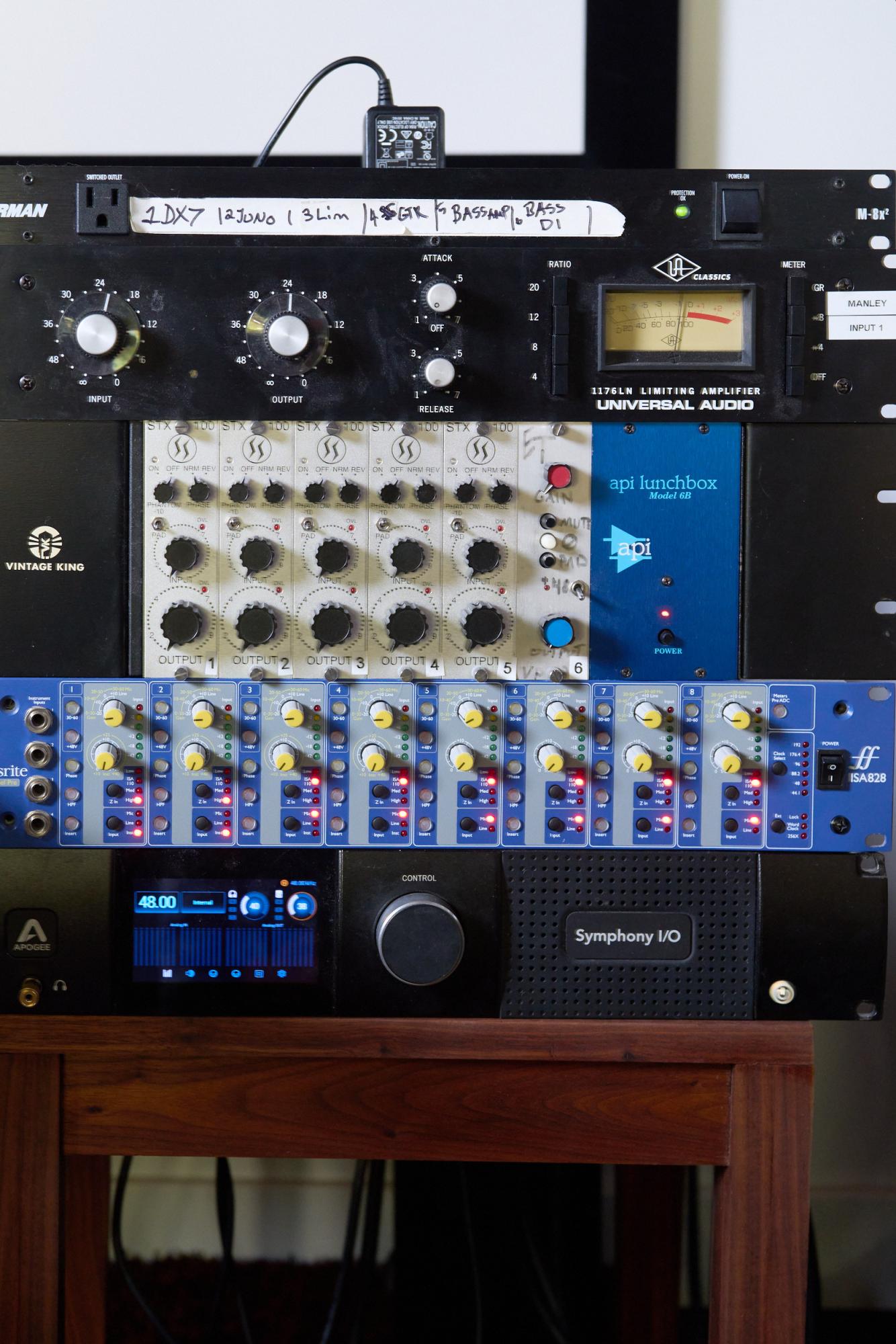
Spotted in the wild: Suzy Shinn's API Lunchbox 500 series rack (center unit in the stack)
Image by Laura Barisonzi
"A 500 Series rack is a specialized enclosure featuring multiple slots that provide power and I/O [input/output] to a variety of modules, ranging from mic amps to multi-effects processors. I like larger (8–11 space) sizes, because they offer a degree of future-proofing when the inevitable 500 Series addiction takes hold. It's a perfect format for the recordist on the go: portable, affordable, and high quality."
The AudioScape 76D Compressor
"The Urei 1176 is widely considered the best FET compressor on the planet, spawning dozens of knock-offs—both analog and digital—and so-called ‘clones’ by scores of companies. The AudioScape 76D is the best I've heard, hands-down; at least, the best I've heard that doesn't require $5,000 or so to snag up a vintage unit in good working condition. FET compression is a great way to tame peaks on virtually any instrument, but is particularly associated with outstanding results on drums, bass, and vocals. It’s a relatively simple-to-operate, great-sounding, and versatile piece of equipment, making it ideal for recordists with limited space looking for a reliable means of dynamics control."
Acoustic Treatment
On this point Grotto is in full agreement with Storyk: "Not the sexiest investment to make, but arguably the biggest bang-for-buck. As the saying goes, ‘garbage in, garbage out.’ The best signal path in the world can't fix bad room acoustics; in fact, they'll usually only reveal them in all their gory detail. Having an assortment of spot treatments is critical for both listening and recording spaces. Companies like GIK offer great premade options, but it's not too hard to build some DIY acoustic panels, or even just buy a bunch of packing blankets to hang on mic stands."
Home Recording Basics
"Recording at home is always about overcoming challenges," says engineer Yuri Lysoivanov(Opens in a new window) BM ’05, an acoustical engineering graduate student at Penn State and product specialist at Shure. "Home recording is something that's very dear to my heart. . . . I record in a lot of non-studio environments—that's my bread and butter."
Lysoivanov's advice skews toward the highly practical, recognizing that a home engineer might be slow to build up their collection of mics and other gear designed to make their recordings sound pristine. "You've got the gear you have," he says. "What can you do to maximize it?"
In home recording, as in so many domains, knowledge is power. If you understand how sound is behaving in your room, and you understand some basics about how certain materials and microphones respond to these acoustic properties, you'll be in a much better position—literally—to capture great audio wherever you're recording.
Acoustics and Standing Waves
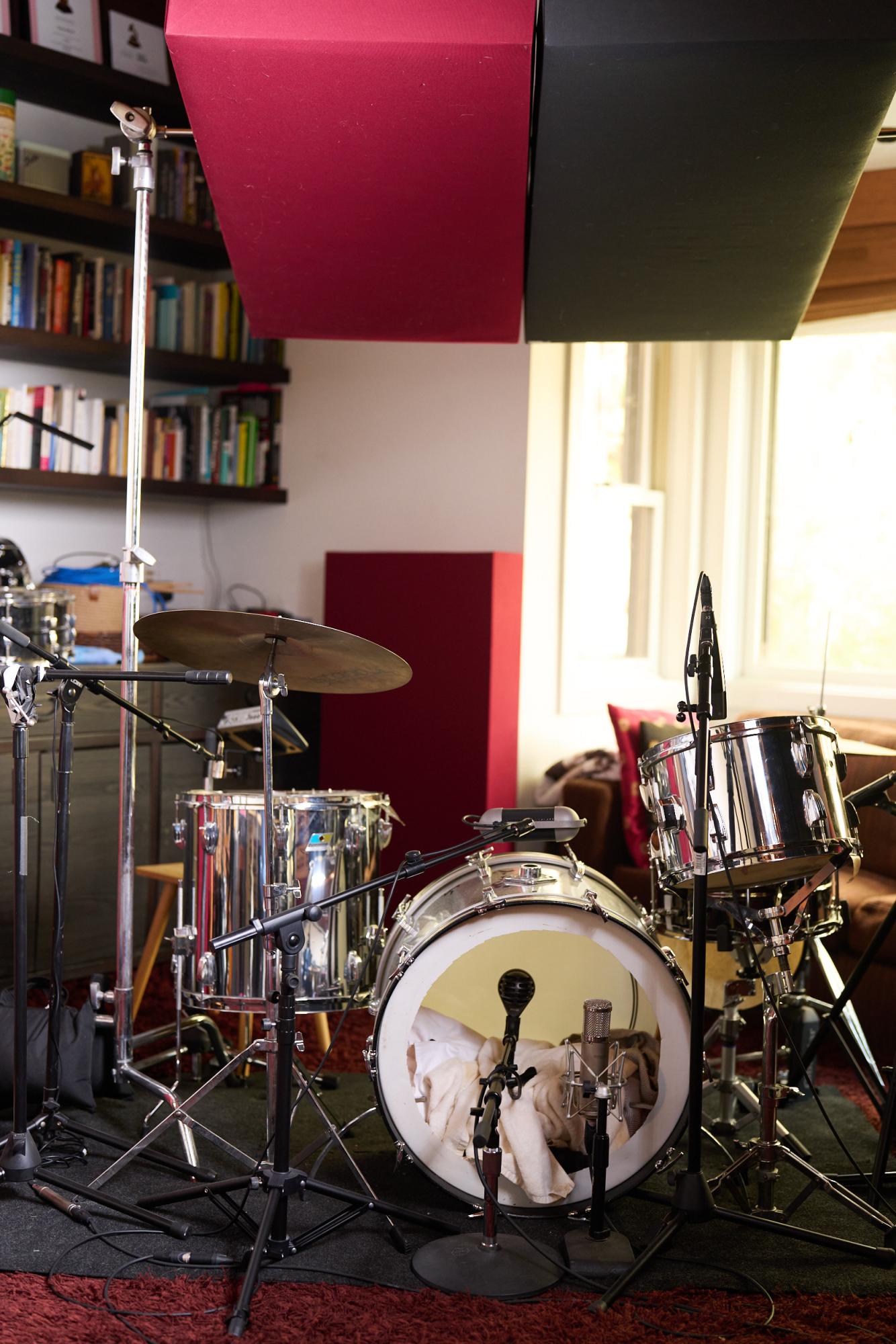
Acoustic treatments surrounding a drum kit in Suzy Shinn's home studio.
Image by Laura Barisonzi
Homes aren't carefully controlled studio rooms. "Acoustics is by far the thing that makes home recording sound bad," says Lysoivanov. "Sometimes things are just going to make noise," he says, and it's not always practical (or affordable) to get rid of that noise. However, being aware of the sources of that noise makes it possible to reduce its effect on a recording.
When thinking about acoustics, in addition to considering what's creating noise in your room, you need to consider how the surfaces in that room are reflecting that noise, especially when it comes to what are called "standing waves."
At certain frequencies, sound waves build up at the walls and cancel out near the center of the room. The frequency (pitch) of these standing waves will change depending on the size of the room. "If you're recording in a smaller room . . . the frequency where this happens is going to increase, and it's probably going to be within your vocal range, or your instrument range," Lysoivanov says. And there's not much a home engineer can do to quiet these waves. "It's not your microphone. It's the room you're in. . . . And you can't change that."
You can, however, make your home recordings sound noticeably better through strategies like targeted acoustic treatments such as those recommended by Storyk and Grotto, mic selection and placement, and audio processing.
Microphone Selection
"The first choice that you have with a microphone is generally whether it's dynamic or condenser," Lysoivanov explains.
Very simply: Dynamic microphones are less sensitive than condenser microphones. "Dynamic [mics] are wonderful microphones for bad rooms because they force you to be closer to them," and they don't pick up as much of the room sound around you.
Condenser microphones, by contrast, are very sensitive. "They pick up everything—every little detail, everything that you could possibly want to hear, including the bad room that you're in."
Of course, this isn't to say you should never use condenser mics—like the ones Grotto recommends above—in home environments. "You just have to understand what they are [and] how they work so that you can make adjustments to make yourself sound better."
You've got the gear you have. . . . What can you do to maximize it?
—
Microphone Placement
The second consideration you make when choosing and using a mic, Lysoivanov says, has to do with the mic's polar pattern—how sensitive a mic is to sound coming from different angles, relative to what they're facing.
Most microphones you'll use in a home recording context have a cardioid pattern, which means they're sensitive to the sound they're pointed at, but "reject almost all of the sound coming into the back, except at low frequencies." This means that you can manage some of those standing waves and unwelcome room noises with a simple trick: position your cardioid mic "where the rear of the mic faces the worst spot in the room"—probably a wall or other sound-reflective surface.
A full breakdown of how to mic every imaginable instrument on a home recording is beyond the scope of what we're doing here, but let's take just a moment to talk about mic placement and vocals.
When recording vocals, many home producers want to replicate the vocal booths they imagine in studios. But without the meticulously engineered soundproofing of those spaces, tight boxes don't do you any favors.
"When I hear somebody record in a closet or in a bathroom, it's going to sound like they recorded in a closet or in a bathroom, primarily because of the standing waves between those walls," says Lysoivanov. "If you can record in a bigger space, usually it sounds better, because you don't have those [higher-frequency] standing waves. You get more of the natural sound of the voice," even if you also have to think a bit more about microphone placement in a bigger room.
Then What? Taking Advantage of Post-Production
"So I've done all I could. I've set up the acoustics in my room, I've picked my microphone, I've picked my microphone placements. I've done everything that I can do acoustically to make the sound as Ideal as possible, but I still have some problems with my recording—maybe because the room sucked, maybe because I forgot something," Lysoivanov says. "Mistakes happen. I'm a professional—I make mistakes. . . . What can you do?"
This is where post-production can help.
Equalization (EQ)
Equalizers are used to accentuate and tame targeted frequencies in a recording. That makes them essential tools for managing rogue sounds in your projects, and for bringing out the best in your audio. "Whether you're an audio engineer or a performing musician," Lysoivanov says, "learn how to use an EQ. Open the stock equalizer [in your DAW] and just start practicing."
"If you have a standing wave in your room at 230 Hz, you might not know it's 230 Hz, but your EQ will tell you and you can knock it down."
Noise Reduction and Noise Removal
For simple noise issues—pulling a loud room out of the silent moments in a vocal or guitar track, for example—a basic noise gate plugin often does the trick, cutting out or reducing all signal below a set decibel threshold. But for more complex issues, like undesirable noises bleeding into the actual performance audio, "this is when programs like iZotope RX come in," says Lysoivanov.
With this program, "you can actually go into your sound and use very sophisticated computer processing to find things that you don't like and . . . completely remove them."
Go into a room, clap. You can hear how the room responds, and you can make your own personal judgments.
—
Reverb
Lysoivanov's last recommendation is to consider how close to the sound source to position your microphones based on how much you like the sound of your room. "You can hear it," he says. "Go into a room, clap. You can hear how the room responds, and you can make your own personal judgments."
And if you don't like the sound of the room? Well, your DAW is full of other room sounds you can choose instead. "I record things up close quite often, so I tend to put on my own reverbs. I record in a lot of bad rooms. I would err on the side of choosing a good digital room [rather] than a bad real room."
Putting It All Together: Pros in Their Home Studios
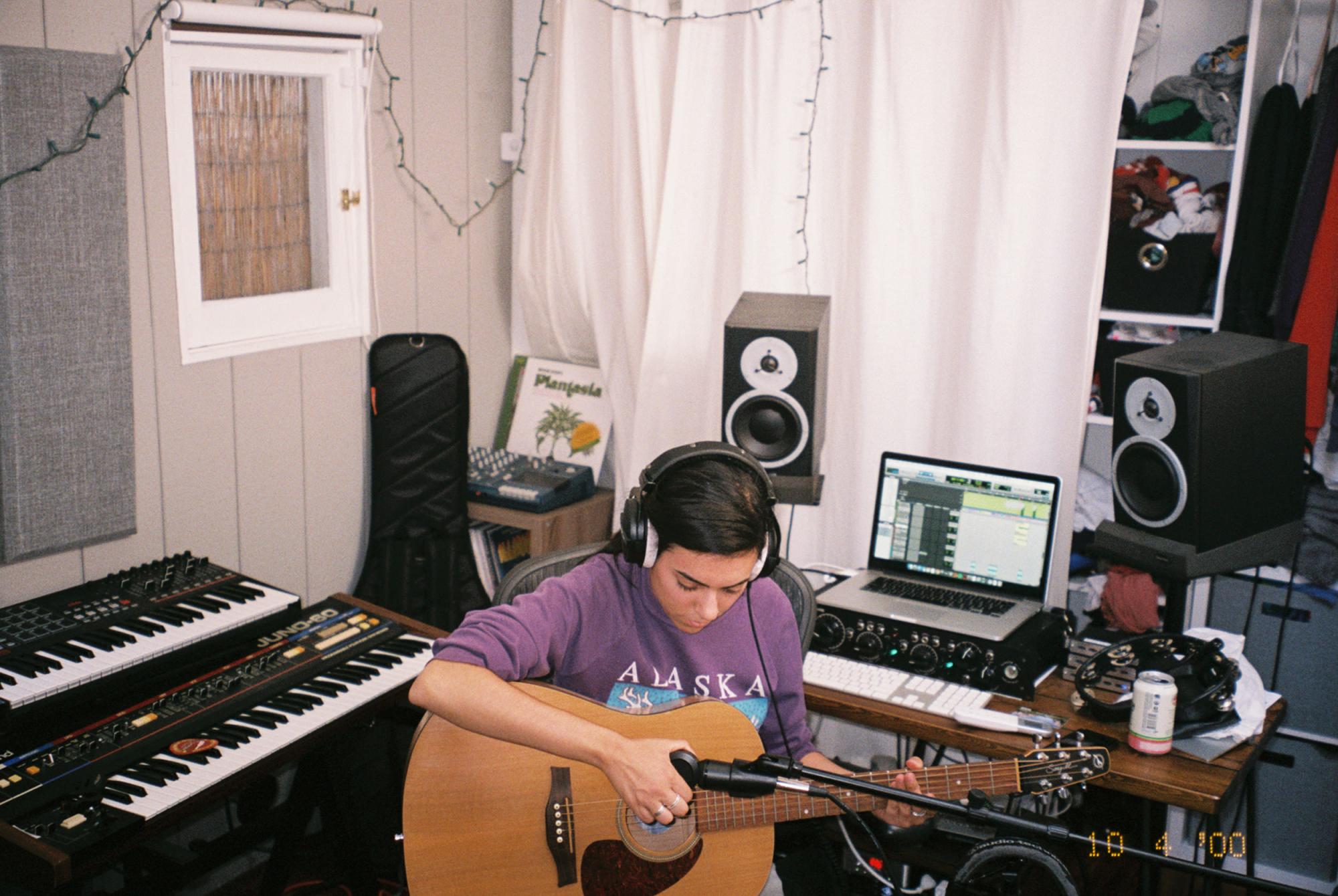
Sarah Tudzin in her home studio
Image by Maddie Ross, courtesy of Tape Op magazine
We spoke to two professional producers, Sarah Tudzin(Opens in a new window) BM ’14 and Suzy Shinn(Opens in a new window) ’11, about their own home recording setups and how they get the most out of a limited remote studio. Both artists began experimenting with home recording in high school, making music with whatever gear they could cobble together, before coming to Berklee and learning the particulars of a professional studio workflow with top-caliber equipment. "Berklee really gave me my first actual recording tools," Shinn reflects.
"Once I got to Berklee, I was exposed to real studio gear and spaces and immediately fell in love with that, and spent a lot of time in the Berklee studios learning the ins and outs, while also feeling like it was a unique experience," says Tudzin. But she acknowledges that this is not necessarily the typical way much music is made these days. "The amount of people that continue to use large format studios like that after college is pretty small now."
For both Tudzin and Shinn, recording at home remains an important part of their process.
Listen to Sarah Tudzin on the Sounds of Berklee podcast:
Illuminati Hotties’ Sarah Tudzin on Getting the Ideas Out
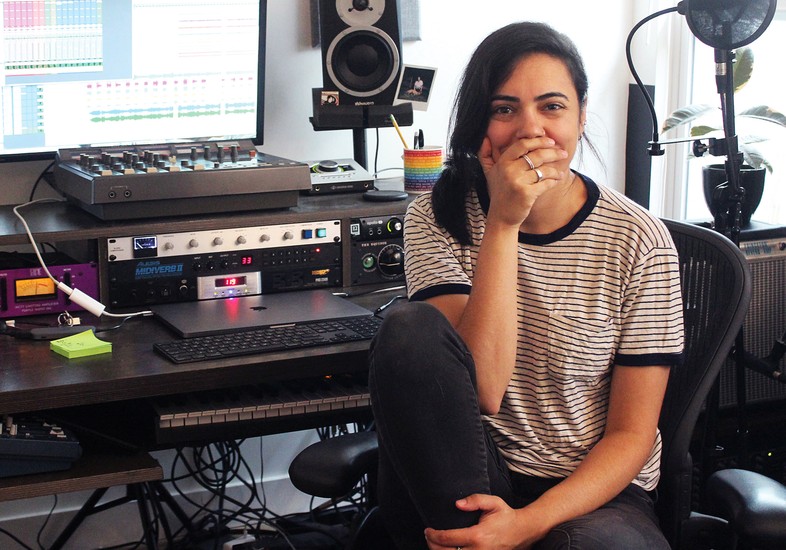
Sarah Tudzin
Image by Maddie Ross, courtesy of Tape Op magazine
In addition to her production and engineering work for acclaimed acts such as boygenius, Weyes Blood, and Pom Pom Squad, and her guest vocals on projects ranging from Disney's Ahsoka original soundtrack to albums by punk bands like PUP and the Armed, Sarah Tudzin is probably best known as the frontperson and auteur behind indie rock band Illuminati Hotties. Her third Illuminati Hotties album, Power, was released in 2024 to widespread and well-deserved acclaim.
Listening to Power, there's nothing to suggest that significant portions of the record were made in Tudzin's home studio. "I did all the demoing at home, and I did a lot of overdubs—vocals, anything that's just a one-person show—at home. . . . I was basically trying to do as much as I could with the tools at my own disposal."
A Hybrid DIY Approach
Tudzin says she's lucky to have access to bigger studios in the LA area "to do bigger sessions, or track drums . . . if I don't want to play drums all day, if it's disturbing the neighbors or something." This is what she did for Power, recording drums and various other parts in studios throughout the process, then taking everything home, where she "combed through everything and replayed some stuff."
It's so quick to go from creation to a working demo when you're using DIY-style techniques.
—
The home studio has "always been part of the setup because it's so quick to go from creation to a working demo when you're using DIY-style techniques." But Tudzin says those demos often evolve into takes worth keeping. "As soon as I'm recording, it starts becoming what I want it to be. . . . Once I'm tracking stuff, I'm really thinking about stuff I want to keep."
"Didn't" by Illuminati Hotties, ft. Cavetown and cowritten by Suzy Shinn
Making ‘Anything Playable Immediately’
In terms of her actual home studio space, Tudzin's setup is fairly simple, using some targeted sound treatment (see John Storyk’s advice above). "My room is basically a square, so I do have panels along the back, and I have a cloud [a ceiling-mounted sound treatment] above," she says. "I have it treated in a way where I'm not being overwhelmed by any wily frequencies."
But Tudzin's main priority is making it easy and fluid to get ideas out quickly. "I don't want to have to plug in stuff or stop a writing session to rewire anything, so I basically just always have a vocal mic, always have a mic on my guitar amp, and then I have a large swath of random keyboards that are all going into one mixer, so then I can basically have any keyboard immediately accessible," she says. The mixer runs into two channels on her audio interface (a Universal Audio Apollo), "and then it's just easy to open up lanes of audio and have anything playable immediately."
In the Home Studio with Suzy Shinn
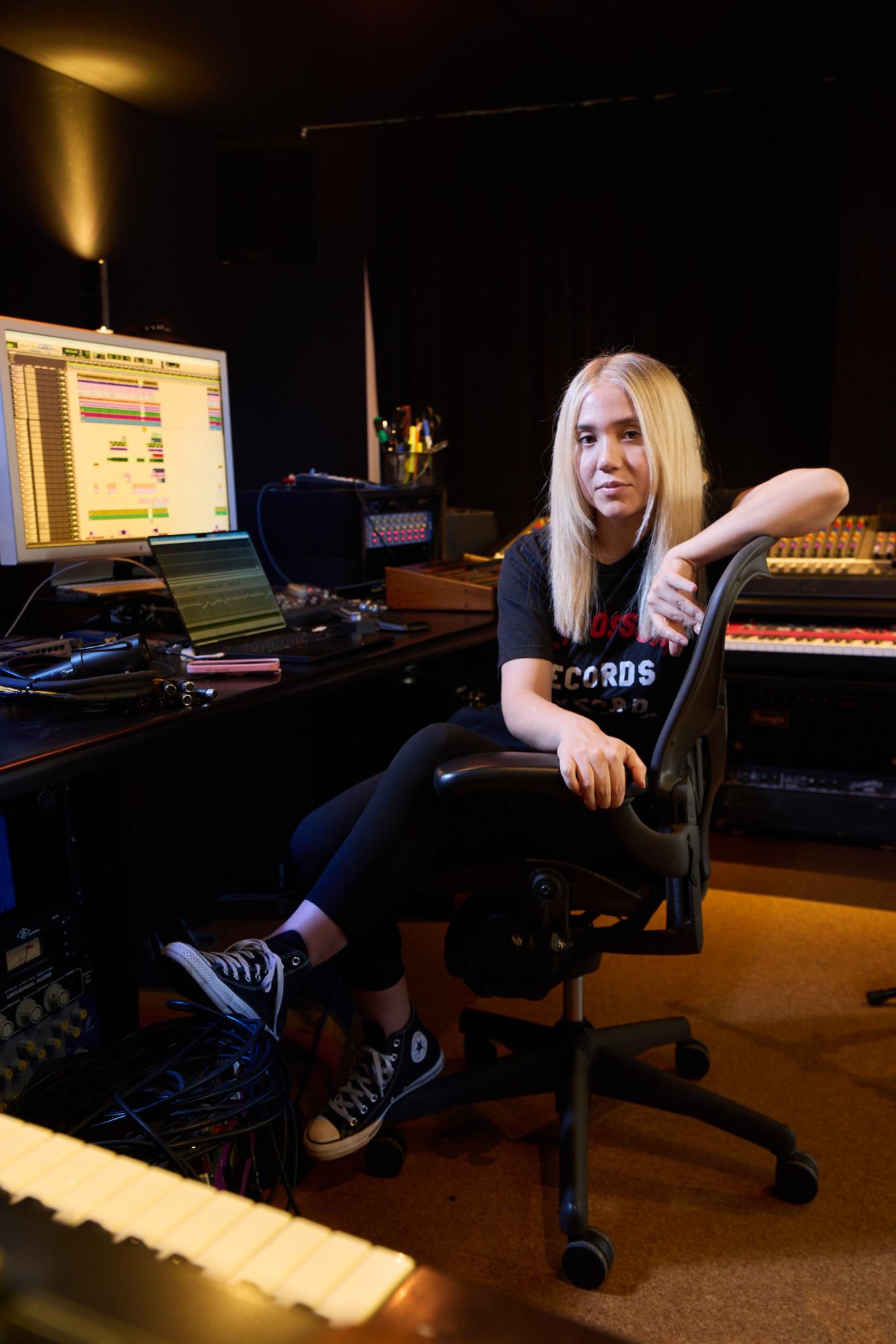
Suzy Shinn
Image by Laura Barisonzi
Suzy Shinn has collaborated as an engineer, producer, and cowriter with artists ranging from Weezer, Panic! at the Disco, and Cherry Glazer to Dua Lipa and Alicia Keys.
She says she mainly uses her home studio for writing and demoing, but as is the case with Tudzin, "a lot of times it will make it into the final process if it's good, if the emotion is there."
Recording at home, "inspiration can strike faster," Shinn says. It takes away the pressure to perfect something in a "big fancy studio. . . . It's more like, 'Oh, come over. You want anything in the kitchen? Go grab it.' We're just hanging out as we did when we were teenagers at our parents' houses, making music in the basement."
Suzy Shinn's Home Studio Gear
In order to do basically whatever she needs in a remote recording context, Shinn says, "all I need is a guitar, any kind of interface, an SM7, a pair of headphones, and a laptop.”
When we asked her what gear she had around currently, she was kind enough to take the full inventory then and there:
- Apollo Twin interface
- A handful of good plugins like FabFilter Pro-Q 3, R-Vox, Valhalla Vintage Verb, and Ozone
- Genelec 8040B monitors
- Tech 21 SansAmp VT Bass pedal
- Strymon Iridium amp and cab modeler
- Ten Years pedal
- A "tiny little Altoids guitar amp"
- Earthquaker Devices Avalanche Run reverb and delay pedal
- Chase Bliss Lossy pedal
- Tuner
- MIDI keyboard
- Chompi sampler
- AEA Active DI Box
- 1990s Fender Jaguar
- Squier J Mascis Jazzmaster
- Nylon string acoustic guitar
- Fender P-Bass
- Yamaha FG-180 acoustic guitar
- Shure SM7B
- Soyuz The Launcher (Cloudlifter)
- Audio Technica headphones
- STX100 Spectra 500 series preamp
"And that's it, more or less. Usually less."

Suzy Shinn's home studio
Image by Laura Barisonzi
How to Make Big Sounds in a Small Room
Shinn's production style runs the gamut, but she has a particular talent for creating huge, crunchy-yet-crisp rock mixes. So we asked her if there was any trick to capturing big studio energy when working out of a small home setup.
'Monica Gives Me Lockjaw' by Frances Forever, produced and cowritten by Suzy Shinn
She says there are a few tricks, for instance, "I know if I have three guitars in the chorus, and two guitars are the same guitar with similar tones and the third one is a really janky, distorted guitar up the middle, that's gonna sound pretty freakin’ good."
But more than specific tricks, for Shinn it comes down to focus and enthusiasm. "I listen fairly quiet and I don't put any plugins on the master until I get towards the end of writing. . . . I try to focus on the song being good, and then focus on the loud, competitive sounding part."
"If you're just excited about the song you're working on," she says, "it will feel that way no matter where you are."
For an even deeper dive into these pros' approach to production, check out Tape Op magazine's interviews with Sarah Tudzin(Opens in a new window) and Suzy Shinn(Opens in a new window).
The Next Great DIY Record
Setting up the home studio is only the beginning of a home producer’s journey. There will always be more tweaks to make, more gear to explore, more techniques for capturing audio, and more software to edit what you record. But with a basic understanding of your room’s acoustics and a fairly limited set of tools, you’ll be ready to start chasing your musical ideas in your own space, on your own terms. The only real foolproof hack at that point is to accept the gear you’ve got in front of you, focus on the musical craft, and stay excited about the project.
Recording at home is often a process of trial, and error, and trying again, but that’s just another way of saying: it’s a process of discovery. What you’ll find along the way is anybody’s guess, but as so many classic DIY records have proven, big and resonant works of art often come from small and noisy rooms.




